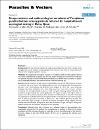Seroprevalence and epidemiological correlates of Toxoplasma gondii infections among patients referred for hospital-based serological testing in Doha, Qatar
| Author | Abu-Madi, Marawan A. |
| Author | Al-Molawi, Naema |
| Author | Behnke, Jerzy M. |
| Available date | 2009-12-28T15:40:28Z |
| Publication Date | 2008 |
| Publication Name | Parasites & Vectors |
| Citation | Abu-Madi, M. a, Al-Molawi, N., & Behnke, J. M. (2008). Seroprevalence and epidemiological correlates of Toxoplasma gondii infections among patients referred for hospital-based serological testing in Doha, Qatar. Parasites & Vectors, 1, 39 |
| ISSN | 1756-3305 |
| Abstract | Background. The city of Doha in Qatar has a high density of feral cats and there is a high risk of toxoplasmosis for the resident human population. No data currently exist for the prevalence of infection with Toxoplasma gondii in the city. Methods. We analysed the serological response to Toxoplasma gondii of 1625 subjects referred for routine hospital based serological tests in Doha, Qatar. Prevalence of current/recent infection was assessed through an enzyme-linked immunosorbent assay (ELISA) for the presence of specific anti-T. gondii IgM antibodies, and previous history of infection through IgG. Results. Overall prevalence of IgG responses was 29.8% and this did not differ between the sexes nor between the three years of the study although there was a marked age effect. Among children less than 1 year old prevalence was 22.9%, but then dropped to <4% in the 1 year old group, indicating that these antibodies were most likely acquired in utero from immune mothers. Prevalence then increased steadily to peak at 41.2% among the oldest age class (>45 years). The prevalence of IgG antibody also varied significantly with region of origin, with higher rates for subjects from Africa, followed by those from the Eastern Mediterranean or Asia and lowest rates for subjects from the Arabian Peninsula. No IgM antibodies were detected in any subjects younger than 19 years, but prevalence increased to plateau at 7 - 9% in subjects aged over 20 years, and also varied with region of origin. In this case prevalence was highest among subjects from the Arabian Peninsula and least among those from Asia. Prevalence of IgM was higher among male subjects but did not vary between the three years of the study. Conclusion. Although these data are based on a selected subset of the population, they nevertheless provide the first evidence that toxoplasmosis is endemic in Qatar in the human population, and that both age and region of origin play a role in the epidemiology of the infection. Concerns relating to the role of high density of feral cats in sustaining the infection were highlighted. |
| Language | en |
| Publisher | BioMed Central |
| Subject | Toxoplasma gondii Seroprevalence serological testing |
| Type | Article |
Files in this item
This item appears in the following Collection(s)
-
Health Sciences-CAS (pre 2016) [151 items ]


